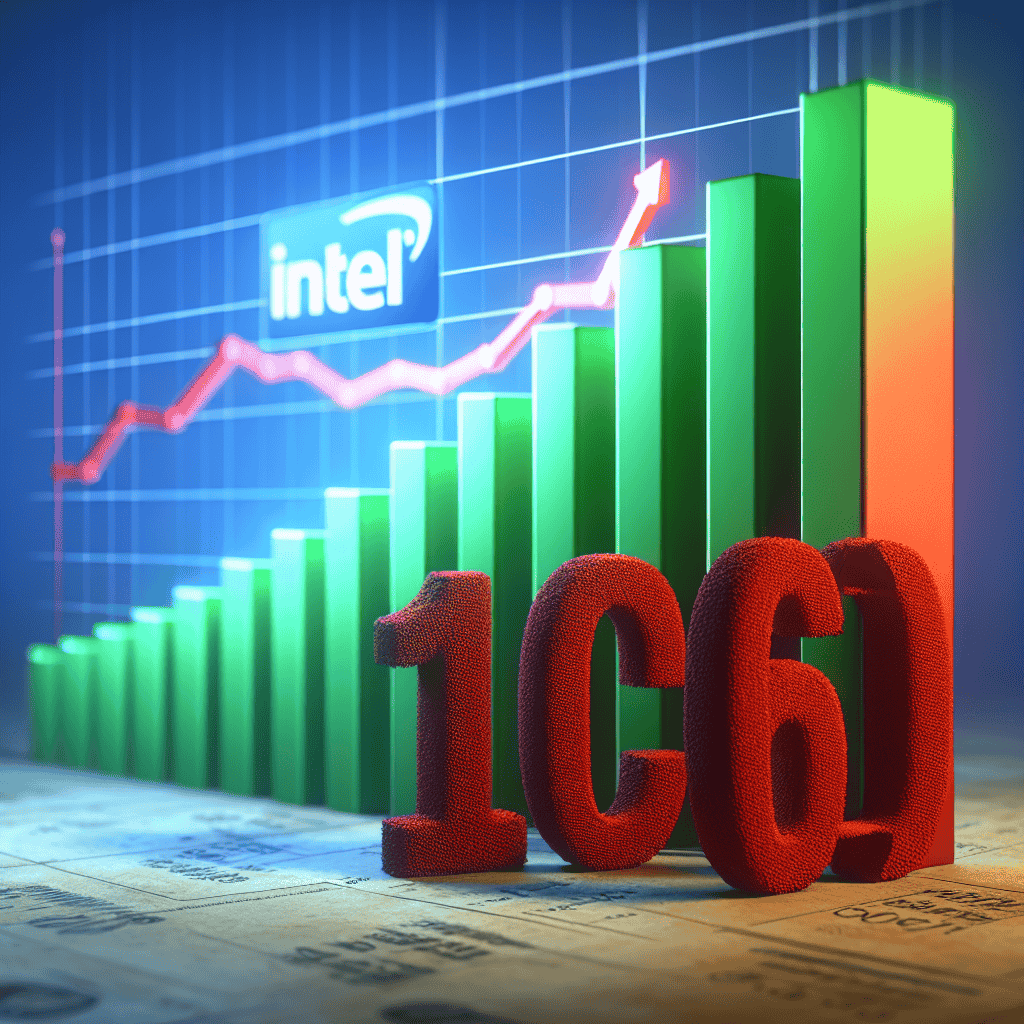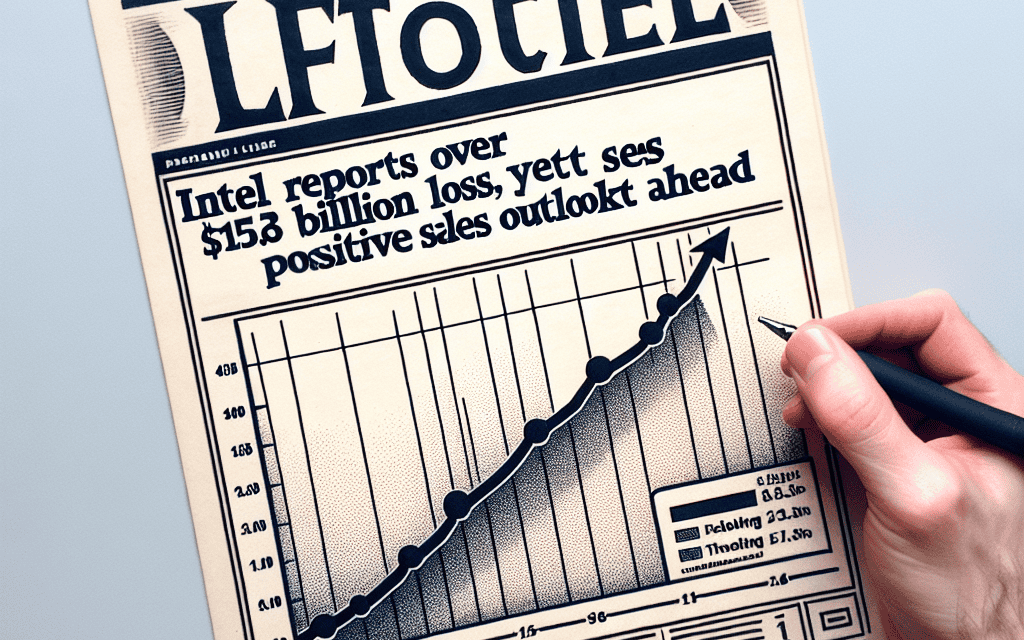“Intel Faces $16 Billion Loss, Yet Optimism Fuels Future Sales Surge”
Introduction
Intel recently reported a staggering loss of over $16 billion, marking a significant financial setback for the technology giant. Despite this substantial deficit, the company remains optimistic about its future sales prospects. Intel’s leadership has expressed confidence in their strategic initiatives and market positioning, suggesting that the current financial challenges are temporary and that a rebound in sales is anticipated. This outlook is bolstered by ongoing investments in innovation and a focus on emerging technologies, which are expected to drive growth and enhance competitiveness in the evolving tech landscape.
Intel’s Financial Turnaround: Analyzing the $16 Billion Loss and Future Sales Projections
Intel Corporation, a leading player in the semiconductor industry, recently reported a staggering loss of over $16 billion, a figure that has undoubtedly raised eyebrows across the financial and tech sectors. This substantial loss, however, does not paint the entire picture of Intel’s current financial health or its future prospects. Despite the daunting figure, Intel remains optimistic about its sales outlook, suggesting a potential turnaround in the near future. To understand this complex scenario, it is essential to delve into the factors contributing to the loss and the reasons behind Intel’s positive sales projections.
The reported loss can be attributed to several key factors, including increased competition, supply chain disruptions, and strategic investments. Over the past few years, Intel has faced intensified competition from companies like AMD and NVIDIA, which have made significant inroads into markets traditionally dominated by Intel. This competitive pressure has forced Intel to invest heavily in research and development to maintain its technological edge, thereby impacting its short-term financial performance. Additionally, global supply chain disruptions, exacerbated by the COVID-19 pandemic, have further strained Intel’s operations, leading to increased costs and delayed product launches.
Moreover, Intel’s strategic investments in new technologies and manufacturing capabilities have also contributed to the financial loss. The company has been aggressively expanding its manufacturing footprint, with plans to build new fabrication plants in the United States and Europe. These investments are part of Intel’s long-term strategy to regain its leadership position in the semiconductor industry and reduce its reliance on external foundries. While these initiatives are capital-intensive and have weighed on Intel’s current financials, they are expected to yield significant returns in the future.
Despite the current financial setback, Intel’s management remains confident about the company’s sales outlook. This optimism is rooted in several factors, including the growing demand for semiconductors across various industries. The proliferation of technologies such as artificial intelligence, 5G, and the Internet of Things has led to an unprecedented demand for advanced chips, a trend that Intel is well-positioned to capitalize on. Furthermore, the company’s recent product launches, including its latest line of processors, have been well-received in the market, indicating strong future sales potential.
In addition to product innovation, Intel’s strategic partnerships and collaborations are expected to bolster its sales growth. The company has been actively forging alliances with key players in the tech ecosystem to enhance its product offerings and expand its market reach. These partnerships are likely to open new revenue streams and drive sales growth in the coming years.
Furthermore, Intel’s commitment to sustainability and corporate responsibility is expected to enhance its brand reputation and customer loyalty, thereby positively impacting sales. The company has set ambitious goals to reduce its carbon footprint and promote sustainable practices across its operations. As consumers and businesses increasingly prioritize sustainability, Intel’s efforts in this area are likely to resonate with stakeholders and contribute to its sales growth.
In conclusion, while Intel’s reported loss of over $16 billion is a significant financial challenge, it is not indicative of the company’s long-term prospects. Through strategic investments, product innovation, and a focus on sustainability, Intel is poised to navigate the current challenges and emerge stronger in the future. The company’s positive sales outlook reflects its resilience and adaptability in a rapidly evolving industry, offering a glimmer of hope amid the financial turbulence.
Understanding Intel’s Strategic Shift Amidst a $16 Billion Loss
Intel Corporation, a titan in the semiconductor industry, recently reported a staggering loss of over $16 billion, a figure that has undoubtedly raised eyebrows across the financial and technological sectors. Despite this significant financial setback, the company remains optimistic about its future sales outlook, a sentiment that may seem paradoxical at first glance. However, a closer examination of Intel’s strategic maneuvers reveals a calculated shift aimed at long-term growth and sustainability.
The reported loss primarily stems from a combination of factors, including increased competition, supply chain disruptions, and substantial investments in research and development. Intel has faced mounting pressure from competitors like AMD and NVIDIA, who have made significant inroads into markets traditionally dominated by Intel. This competitive landscape has necessitated a reevaluation of Intel’s strategies, prompting the company to invest heavily in innovation and infrastructure to maintain its market position.
Moreover, the global semiconductor shortage has exacerbated Intel’s challenges, disrupting production schedules and affecting revenue streams. This shortage, driven by a surge in demand for electronic devices and automotive components, has highlighted the vulnerabilities in the supply chain. In response, Intel has embarked on an ambitious plan to expand its manufacturing capabilities, including the construction of new fabrication plants. These investments, while costly in the short term, are expected to enhance Intel’s production capacity and reduce dependency on external suppliers.
In addition to addressing immediate operational challenges, Intel is also focusing on diversifying its product portfolio. The company is making strategic moves into emerging markets such as artificial intelligence, autonomous vehicles, and 5G technology. By leveraging its expertise in semiconductor design and manufacturing, Intel aims to capture a significant share of these high-growth sectors. This diversification strategy is not only intended to mitigate risks associated with its traditional markets but also to position Intel as a leader in next-generation technologies.
Furthermore, Intel’s leadership has expressed confidence in the company’s ability to rebound from its current financial predicament. CEO Pat Gelsinger has emphasized the importance of a long-term vision, underscoring the need for patience and perseverance as Intel navigates this transitional phase. The company’s commitment to innovation and its proactive approach to addressing industry challenges are seen as key drivers of future growth.
Despite the daunting financial figures, Intel’s positive sales outlook is supported by several encouraging indicators. The global demand for semiconductors continues to rise, driven by advancements in technology and the proliferation of connected devices. Intel’s strategic investments in expanding its manufacturing footprint and diversifying its product offerings are expected to yield substantial returns as these trends unfold.
In conclusion, while Intel’s $16 billion loss may appear alarming, it is essential to view this figure within the context of the company’s broader strategic objectives. By investing in innovation, expanding its manufacturing capabilities, and diversifying its product portfolio, Intel is positioning itself for sustained growth in an increasingly competitive and dynamic industry. The company’s optimistic sales outlook reflects a belief in its ability to adapt and thrive amidst challenges, underscoring the resilience and forward-thinking approach that has defined Intel’s legacy in the semiconductor market. As the company continues to execute its strategic initiatives, stakeholders will be keenly observing how these efforts translate into tangible results in the coming years.
How Intel Plans to Overcome a $16 Billion Loss with a Positive Sales Outlook
Intel Corporation, a leading player in the semiconductor industry, recently reported a staggering loss of over $16 billion, a figure that has undoubtedly raised eyebrows across the financial and tech sectors. Despite this significant setback, the company remains optimistic about its future sales prospects, a sentiment that may seem paradoxical at first glance. However, a closer examination of Intel’s strategic initiatives and market positioning reveals a comprehensive plan aimed at overcoming current challenges and capitalizing on emerging opportunities.
To begin with, Intel’s financial loss can be attributed to a confluence of factors, including supply chain disruptions, increased competition, and a global economic slowdown. The semiconductor industry has been particularly hard-hit by these issues, with many companies struggling to meet demand while navigating logistical hurdles. Intel, however, is not resting on its laurels. The company has embarked on a series of strategic investments and innovations designed to bolster its market position and drive future growth.
One of the key components of Intel’s strategy is its commitment to expanding its manufacturing capabilities. The company has announced plans to invest heavily in new fabrication facilities, or fabs, which are essential for producing advanced semiconductor chips. By increasing its production capacity, Intel aims to reduce its reliance on external suppliers and mitigate the impact of supply chain disruptions. This move is expected to enhance the company’s ability to meet growing demand for its products, particularly in high-growth areas such as data centers and artificial intelligence.
In addition to expanding its manufacturing footprint, Intel is also focusing on technological innovation as a means of regaining its competitive edge. The company is investing in research and development to advance its chip architecture and improve performance. This includes the development of next-generation processors that promise to deliver significant improvements in speed and efficiency. By staying at the forefront of technological advancements, Intel hopes to differentiate itself from competitors and capture a larger share of the market.
Moreover, Intel is actively pursuing strategic partnerships and collaborations to strengthen its position in the industry. By working with other tech giants and industry leaders, the company aims to leverage synergies and accelerate the development of cutting-edge technologies. These partnerships are expected to open new avenues for growth and provide Intel with access to a broader customer base.
Furthermore, Intel’s positive sales outlook is supported by favorable market trends. The demand for semiconductors is projected to rise significantly in the coming years, driven by the proliferation of connected devices, the expansion of cloud computing, and the increasing adoption of artificial intelligence. Intel is well-positioned to benefit from these trends, given its extensive product portfolio and strong brand recognition.
In conclusion, while Intel’s recent financial loss is undeniably significant, the company’s proactive approach to addressing its challenges and capitalizing on market opportunities paints a promising picture for the future. Through strategic investments in manufacturing, technological innovation, and strategic partnerships, Intel is laying the groundwork for a robust recovery and sustained growth. As the semiconductor industry continues to evolve, Intel’s ability to adapt and innovate will be crucial in overcoming its current setbacks and achieving its long-term objectives. With a positive sales outlook on the horizon, Intel remains a formidable force in the tech industry, poised to navigate the complexities of the modern market landscape.
The Impact of Intel’s $16 Billion Loss on the Semiconductor Industry

Intel’s recent financial disclosure, revealing a staggering loss of over $16 billion, has sent ripples through the semiconductor industry, raising questions about the broader implications for this critical sector. Despite this significant financial setback, Intel remains optimistic about its future sales prospects, a sentiment that warrants a closer examination of the factors at play. The semiconductor industry, a cornerstone of modern technology, is no stranger to volatility. Companies within this sector often face challenges such as fluctuating demand, supply chain disruptions, and intense competition. Intel’s recent loss, however, stands out due to its magnitude and the company’s historical position as a leader in the industry. This financial downturn can be attributed to several factors, including increased competition from rivals like AMD and NVIDIA, as well as the global economic slowdown that has affected consumer spending on electronics.
Moreover, the semiconductor industry has been grappling with a global chip shortage, exacerbated by the COVID-19 pandemic. This shortage has disrupted production lines and delayed product launches, further impacting companies’ financial performance. Intel, despite its robust infrastructure and resources, has not been immune to these challenges. However, the company’s optimistic sales outlook suggests a strategic pivot aimed at regaining its competitive edge. Intel’s confidence in its future sales is likely rooted in its ongoing investments in research and development. The company has been focusing on advancing its manufacturing processes, with plans to introduce new technologies that promise to enhance chip performance and efficiency. By doing so, Intel aims to meet the growing demand for high-performance computing solutions, driven by emerging technologies such as artificial intelligence, 5G, and the Internet of Things.
Furthermore, Intel’s strategic partnerships and collaborations with other tech giants could play a crucial role in its recovery. By leveraging these alliances, Intel can expand its market reach and tap into new customer segments. This approach not only diversifies its revenue streams but also mitigates risks associated with over-reliance on specific markets or products. In addition to these strategic initiatives, Intel’s commitment to sustainability and ethical practices may also bolster its reputation and appeal to socially conscious consumers and investors. As environmental concerns continue to shape consumer preferences and regulatory landscapes, companies that prioritize sustainability are likely to gain a competitive advantage.
While Intel’s financial loss is undeniably significant, it is essential to consider the broader context of the semiconductor industry. The sector is characterized by rapid technological advancements and cyclical market trends, which can lead to periods of both growth and contraction. Intel’s current situation, therefore, may be viewed as part of a larger industry cycle, with potential for recovery and growth in the coming years. In conclusion, Intel’s $16 billion loss has undoubtedly raised concerns within the semiconductor industry. However, the company’s positive sales outlook, driven by strategic investments, partnerships, and a focus on innovation, suggests that it is well-positioned to navigate these challenges. As the industry continues to evolve, Intel’s ability to adapt and capitalize on emerging opportunities will be crucial in determining its future trajectory. Consequently, stakeholders within the semiconductor sector will be closely monitoring Intel’s progress, as it could have far-reaching implications for the industry’s overall health and competitiveness.
Intel’s Resilience: Navigating a $16 Billion Loss and Optimistic Sales Forecasts
Intel Corporation, a leading player in the semiconductor industry, recently reported a staggering loss of over $16 billion. This financial setback, while significant, has not deterred the company from maintaining an optimistic outlook on future sales. The loss, primarily attributed to a combination of global supply chain disruptions, increased competition, and a slowdown in consumer demand, marks one of the most challenging periods in Intel’s history. However, the company remains steadfast in its commitment to innovation and market leadership, which it believes will drive a positive turnaround in the near future.
The semiconductor industry has been grappling with unprecedented challenges over the past few years. The COVID-19 pandemic exacerbated existing supply chain issues, leading to shortages and delays that have affected production timelines and increased costs. Intel, like many of its peers, has had to navigate these turbulent waters while simultaneously investing in new technologies and infrastructure to meet evolving market demands. Despite these hurdles, Intel’s leadership is confident that the company’s strategic initiatives will pave the way for a robust recovery.
One of the key factors contributing to Intel’s optimistic sales outlook is its aggressive investment in research and development. The company has consistently prioritized innovation, channeling significant resources into the development of next-generation chips and technologies. This forward-thinking approach is expected to position Intel favorably as the demand for advanced computing solutions continues to grow. Moreover, Intel’s focus on expanding its manufacturing capabilities, particularly in the United States and Europe, is anticipated to enhance its competitive edge and mitigate future supply chain risks.
In addition to its technological advancements, Intel is also banking on the resurgence of key markets to bolster its sales. The data center segment, which has been a major revenue driver for the company, is projected to experience renewed growth as businesses increasingly rely on cloud computing and artificial intelligence solutions. Furthermore, the anticipated recovery in the personal computer market, driven by the ongoing digital transformation and remote work trends, is likely to contribute positively to Intel’s bottom line.
Intel’s strategic partnerships and collaborations also play a crucial role in its optimistic outlook. By forging alliances with industry leaders and expanding its ecosystem, Intel aims to accelerate the adoption of its technologies across various sectors. These partnerships not only enhance Intel’s market reach but also foster innovation through shared expertise and resources. As a result, Intel is well-positioned to capitalize on emerging opportunities and drive sustainable growth.
While the $16 billion loss is undoubtedly a significant setback, Intel’s resilience and strategic foresight offer a glimmer of hope for the future. The company’s unwavering commitment to innovation, coupled with its proactive measures to address supply chain challenges and capitalize on market trends, underscores its determination to overcome adversity. As Intel navigates this challenging period, its focus on long-term growth and value creation remains steadfast.
In conclusion, Intel’s recent financial loss, though substantial, does not overshadow the company’s potential for recovery and growth. With a strong emphasis on innovation, strategic investments, and market expansion, Intel is poised to emerge stronger and more competitive in the ever-evolving semiconductor landscape. As the company continues to adapt and innovate, its positive sales outlook serves as a testament to its resilience and enduring commitment to excellence.
Key Factors Behind Intel’s $16 Billion Loss and Their Path Forward
Intel Corporation, a leading player in the semiconductor industry, recently reported a staggering loss of over $16 billion, a figure that has raised eyebrows across the financial and tech sectors. This substantial loss, however, is not entirely unexpected given the myriad of challenges the company has faced in recent years. Despite this financial setback, Intel remains optimistic about its future sales outlook, driven by strategic initiatives and market dynamics that could potentially turn the tide in its favor.
To understand the factors contributing to Intel’s significant loss, it is essential to consider the broader context of the semiconductor industry. The past few years have been marked by intense competition, with companies like AMD and NVIDIA making significant inroads into markets traditionally dominated by Intel. This increased competition has pressured Intel to innovate rapidly and invest heavily in research and development, which, while necessary, has also strained its financial resources. Moreover, the global semiconductor shortage, exacerbated by the COVID-19 pandemic, has disrupted supply chains and affected production schedules, further impacting Intel’s bottom line.
In addition to these industry-wide challenges, Intel has faced internal hurdles that have contributed to its financial woes. The company has been undergoing a significant transformation, shifting its focus from being a PC-centric company to a data-centric one. This strategic pivot requires substantial investment in new technologies and infrastructure, which has temporarily weighed down its financial performance. Furthermore, Intel has been grappling with delays in the rollout of its next-generation chips, which has allowed competitors to gain a foothold in key markets.
Despite these challenges, Intel’s leadership remains confident about the company’s future prospects. One of the key reasons for this optimism is the anticipated growth in demand for semiconductors across various sectors. The proliferation of technologies such as artificial intelligence, 5G, and the Internet of Things is expected to drive significant demand for advanced chips, providing Intel with ample opportunities to capitalize on its investments in these areas. Additionally, the company’s recent strategic partnerships and acquisitions are poised to enhance its capabilities and expand its market reach.
Moreover, Intel’s commitment to innovation is evident in its ambitious roadmap for future product releases. The company has announced plans to accelerate the development of its next-generation chips, with a focus on improving performance and energy efficiency. These advancements are expected to strengthen Intel’s competitive position and attract new customers, thereby boosting sales in the coming years. Furthermore, Intel’s efforts to diversify its product portfolio and enter new markets, such as autonomous vehicles and cloud computing, are likely to open up additional revenue streams.
In conclusion, while Intel’s recent financial loss is undeniably significant, it is not indicative of the company’s long-term potential. The challenges it faces are not insurmountable, and its strategic initiatives are well-aligned with emerging market trends. By leveraging its strengths in innovation and technology, Intel is well-positioned to navigate the current landscape and emerge stronger in the future. As the demand for semiconductors continues to grow, Intel’s positive sales outlook suggests that the company is on a path to recovery, with the potential to regain its leadership position in the industry.
Intel’s Financial Challenges: Lessons from a $16 Billion Loss and Future Opportunities
Intel Corporation, a titan in the semiconductor industry, recently reported a staggering loss of over $16 billion, a figure that has sent ripples through the financial and tech communities alike. This substantial financial setback, while alarming at first glance, offers a deeper narrative about the challenges and opportunities facing the company. Despite the daunting loss, Intel remains optimistic about its future sales outlook, suggesting that the company is poised to navigate through these turbulent times with strategic foresight and resilience.
The reported loss can be attributed to a confluence of factors that have beset the semiconductor industry. Global supply chain disruptions, exacerbated by the COVID-19 pandemic, have significantly impacted production capabilities and delivery timelines. Additionally, the intensifying competition from other semiconductor giants, such as AMD and NVIDIA, has put pressure on Intel to innovate and adapt rapidly. These competitors have made significant inroads into markets traditionally dominated by Intel, further complicating the company’s financial landscape.
Moreover, the rapid evolution of technology and the increasing demand for more efficient and powerful chips have necessitated substantial investment in research and development. Intel has been compelled to allocate significant resources to stay ahead in the race for technological supremacy. This investment, while crucial for long-term growth, has contributed to the immediate financial strain reflected in the recent loss. However, it is important to note that such investments are often pivotal in securing a competitive edge in the future.
Despite these challenges, Intel’s leadership remains confident in the company’s ability to rebound. The optimism is not unfounded; Intel has a robust history of overcoming adversities and emerging stronger. The company has announced plans to revamp its product line, focusing on next-generation chips that promise enhanced performance and energy efficiency. This strategic pivot is expected to capture a larger share of the burgeoning market for advanced computing solutions, including artificial intelligence and machine learning applications.
Furthermore, Intel’s commitment to expanding its manufacturing capabilities is a testament to its forward-looking approach. The company has unveiled plans to build new fabrication facilities, or fabs, which are expected to bolster its production capacity and reduce dependency on external suppliers. This move is anticipated to mitigate some of the supply chain challenges that have plagued the industry, thereby stabilizing Intel’s operational framework.
In addition to these strategic initiatives, Intel is also exploring partnerships and collaborations to enhance its technological offerings. By leveraging synergies with other tech companies, Intel aims to accelerate innovation and bring cutting-edge solutions to market more swiftly. These collaborations are likely to open new revenue streams and diversify Intel’s portfolio, providing a buffer against future market volatility.
In conclusion, while Intel’s recent financial loss is undeniably significant, it serves as a catalyst for introspection and strategic realignment. The company’s proactive measures to address current challenges and capitalize on future opportunities underscore its resilience and adaptability. As Intel navigates this complex landscape, its focus on innovation, expansion, and collaboration positions it well for a promising sales outlook. The lessons learned from this financial setback are likely to fortify Intel’s foundation, enabling it to thrive in an increasingly competitive and dynamic industry.
Q&A
1. **What was Intel’s reported financial loss?**
Intel reported a financial loss of over $16 billion.
2. **What is Intel’s outlook on future sales?**
Despite the loss, Intel sees a positive sales outlook ahead.
3. **What factors contributed to Intel’s financial loss?**
The loss was primarily due to declining demand in the PC market and increased competition.
4. **How did Intel’s stock react to the financial report?**
Intel’s stock showed resilience, with investors focusing on the positive sales outlook.
5. **What strategies is Intel implementing to improve future performance?**
Intel is focusing on expanding its data center business and investing in new technologies.
6. **How does Intel plan to address competition in the semiconductor industry?**
Intel plans to enhance its product offerings and increase production efficiency.
7. **What are analysts’ views on Intel’s future prospects?**
Analysts are cautiously optimistic, noting the potential for recovery if Intel successfully executes its strategic plans.
Conclusion
Intel’s report of a $16 billion loss highlights significant financial challenges, likely stemming from market fluctuations, increased competition, or strategic missteps. Despite this substantial loss, the company’s optimistic sales outlook suggests confidence in its future product offerings, market strategy, or anticipated industry trends. This positive forecast may be driven by expected demand in emerging technologies, successful cost-cutting measures, or new partnerships and innovations. Intel’s ability to navigate these losses while maintaining a positive outlook indicates resilience and potential for recovery, contingent on effective execution of its strategic plans.





